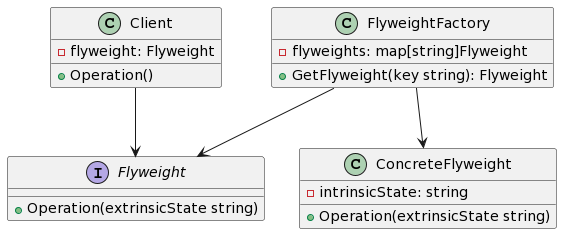1. What is the Flyweight Pattern
1.1 Definition and Concept
The Flyweight Pattern is a structural design pattern whose main purpose is to minimize the number of shared objects, thus saving memory and improving performance. The Flyweight Pattern reduces the creation and consumption of objects by sharing the same or similar objects, achieving performance optimization.
1.2 Difference from Other Design Patterns
Compared to other design patterns, the Flyweight Pattern mainly focuses on the sharing and reusing of objects. It divides objects into shareable internal states and unshareable external states. By sharing internal states, it reduces the creation and memory consumption of objects, improving the efficiency of the system.
2. Characteristics and Advantages of the Flyweight Pattern
The main characteristics and advantages of the Flyweight Pattern include:
- Minimized memory usage: It reduces memory consumption by sharing the same or similar objects.
- Improved performance: It reduces the creation and destruction of objects, speeding up the system’s operation.
- Support for a large number of fine-grained objects: It can create a large number of fine-grained objects without occupying too much memory space.
- Simplified system structure: By separating the internal and external states of objects, it simplifies the system’s structure and complexity.
3. Examples of Practical Applications of the Flyweight Pattern
The Flyweight Pattern can be applied in the following scenarios:
- Particle objects in games: The properties of each particle object can be divided into internal and external states, and particle objects with the same properties can be shared.
- Connection objects in network servers: The properties of connection objects can be divided into internal and external states, and existing connection objects can be reused before being recycled.
4. Implementation of the Flyweight Pattern in Golang
4.1 UML Class Diagram
The UML class diagram of the Flyweight Pattern in Golang is as follows:

4.2 Example Introduction
In this example, we will create a graphic editor based on the Flyweight Pattern, containing circles of different colors, and reduce memory usage by sharing circle objects with the same color.
4.3 Implementation Steps
4.3.1 Create Flyweight Interface and Concrete Flyweight Class
First, we need to create a Flyweight interface to define the operations of shared objects. Then, we can create a ConcreteFlyweight class to implement the Flyweight interface and include internal states.
// Flyweight defines the interface of flyweight objects
type Flyweight interface {
Operation(extrinsicState string)
}
// ConcreteFlyweight represents the concrete flyweight object, implementing the Flyweight interface
type ConcreteFlyweight struct {
intrinsicState string
}
// Operation implements the operation method of the shared object
func (f *ConcreteFlyweight) Operation(extrinsicState string) {
fmt.Printf("Concrete flyweight object, internal state: %s, external state: %s\n", f.intrinsicState, extrinsicState)
}
4.3.2 Create FlyweightFactory Class
Next, we can create a FlyweightFactory class to manage and share flyweight objects. This factory class maintains a flyweights dictionary to store the created flyweight objects.
// FlyweightFactory class
type FlyweightFactory struct {
flyweights map[string]Flyweight
}
// GetFlyweight retrieves or creates a flyweight object from the factory
func (f *FlyweightFactory) GetFlyweight(key string) Flyweight {
if fw, ok := f.flyweights[key]; ok {
return fw
}
flyweight := &ConcreteFlyweight{
intrinsicState: key,
}
f.flyweights[key] = flyweight
return flyweight
}
4.3.3 Client Call Example
Finally, we can create a Client class to demonstrate how to use the flyweight pattern to implement a graphics editor.
// Client class
type Client struct {
flyweight Flyweight
}
// Operation performs an operation
func (c *Client) Operation() {
c.flyweight.Operation("external state")
}
4.4 Implementation Considerations and Best Practices
4.4.1 State Sharing and Thread Safety
When using the flyweight pattern, attention needs to be paid to the sharing of internal state and thread safety. Since flyweight objects are shared by multiple clients, it is necessary to ensure the consistency of the internal state.
4.4.2 Object Pool Management
To better manage and reuse flyweight objects, object pools can be used to store the created flyweight objects. Object pools can increase the reuse rate of objects and reduce the overhead of object creation and destruction.
4.4.3 External Management of Object State
The flyweight pattern separates the internal state and external state of objects, but the external state needs to be managed by the client. When using flyweight objects, the client needs to pass the external state to the flyweight object for operation.
Complete Code Example
Below is a complete Golang code example:
package main
import "fmt"
// Flyweight defines the interface of a flyweight object
type Flyweight interface {
Operation(extrinsicState string)
}
// ConcreteFlyweight represents a specific flyweight object and implements the Flyweight interface
type ConcreteFlyweight struct {
intrinsicState string
}
// Operation implements the operation method for shared objects
func (f *ConcreteFlyweight) Operation(extrinsicState string) {
fmt.Printf("Concrete flyweight object, internal state: %s, external state: %s\n", f.intrinsicState, extrinsicState)
}
// FlyweightFactory class
type FlyweightFactory struct {
flyweights map[string]Flyweight
}
// GetFlyweight retrieves or creates a flyweight object from the factory
func (f *FlyweightFactory) GetFlyweight(key string) Flyweight {
if fw, ok := f.flyweights[key]; ok {
return fw
}
flyweight := &ConcreteFlyweight{
intrinsicState: key,
}
f.flyweights[key] = flyweight
return flyweight
}
// Client class
type Client struct {
flyweight Flyweight
}
// Operation performs an operation
func (c *Client) Operation() {
c.flyweight.Operation("external state")
}
func main() {
factory := &FlyweightFactory{
flyweights: make(map[string]Flyweight),
}
flyweight1 := factory.GetFlyweight("A")
flyweight1.Operation("external state 1")
flyweight2 := factory.GetFlyweight("B")
flyweight2.Operation("external state 2")
client := &Client{
flyweight: factory.GetFlyweight("A"),
}
client.Operation()
}